Many people drink coffee and can think of many places, such as Ethiopia, Colombia, Indonesia, etc. But really, when it comes to production, Brazil is the rightful big brother. This article we will learn about the world's first coffee production Brazil's coffee.
Basic information on Brazil
The Federative Republic of Brazil (Portuguese: República Federativa do Brasil), commonly known as Brazil (Brasil), is the largest country in Latin America. Brazil has the world's largest tropical rainforest and the country's name derives from the Brazilian redwood. The capital is Brasilia, with major cities such as São Paulo and Rio de Janeiro. Brazil has large, high-quality iron ore reserves and is among the world's largest producers and exporters. Brazil is an important exporter of tropical cash crops, and ranks first in the world in the production of coffee, sugar cane and citrus.
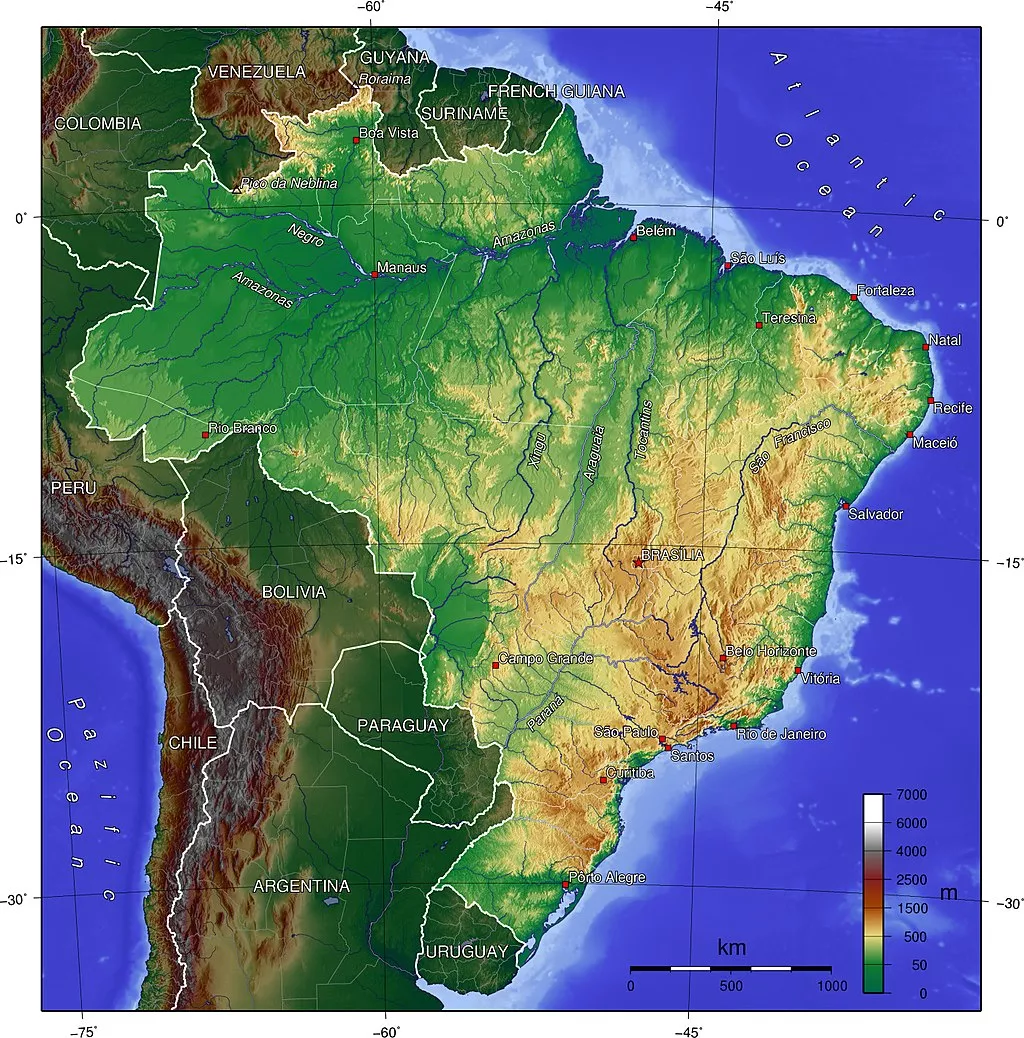 ## Administrative divisions
## Administrative divisions
The coffee industry I personally believe is labor intensive and requires a lot of labor for gathering, handling, and transportation. Therefore areas with higher population density are well suited for coffee cultivation, especially on a large scale, if the natural conditions are suitable.
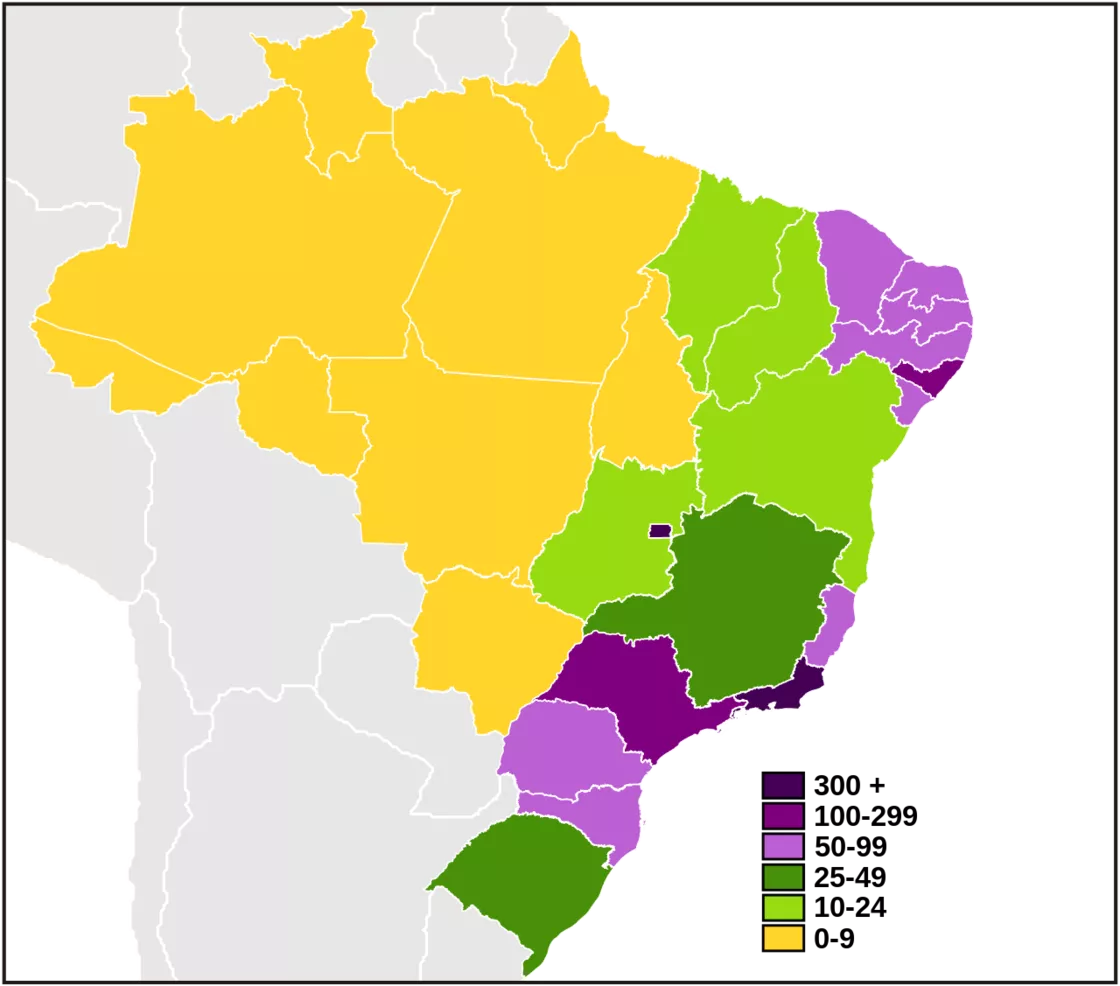 Brazil's federal states population density compared to the intricacies of Ethiopia, Brazil's administrative divisions are clearer, there is nothing particularly gripping and confusing nomenclature, the following synthesis of information from various sources, the entire pulse of the Brazilian coffee industry, for reference only.
Brazil's federal states population density compared to the intricacies of Ethiopia, Brazil's administrative divisions are clearer, there is nothing particularly gripping and confusing nomenclature, the following synthesis of information from various sources, the entire pulse of the Brazilian coffee industry, for reference only.
History of coffee
Brazil has been the world's largest coffee producer, accounting for approximately one-third of the world's coffee production. According to 2020 statistics, Brazil continues to lead the coffee industry in first place with a total global production share of 37.4%. It is the second to fourth place combined.
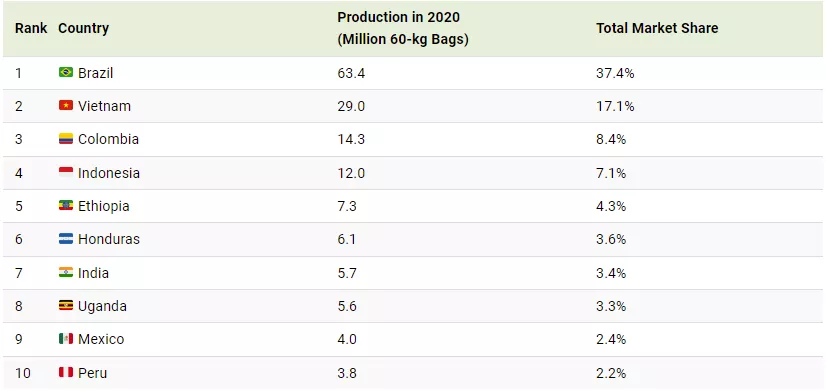 Photo Credit: The World's Top Coffee Producing CountriesThe latest coffee report released by the Brazilian Ministry of Agriculture, Livestock and Supply (Mapa) shows that Brazil is expected to produce a total of 55.73 million bags (60KG/bag) of coffee in 2022, with 1.82 million hectares under cultivation.
Photo Credit: The World's Top Coffee Producing CountriesThe latest coffee report released by the Brazilian Ministry of Agriculture, Livestock and Supply (Mapa) shows that Brazil is expected to produce a total of 55.73 million bags (60KG/bag) of coffee in 2022, with 1.82 million hectares under cultivation.
Arabica coffee production is estimated at 38.78 million bags, up 23.4% year-on-year. The area planted is 1.43 million hectares, a slight decrease of 0.2%, and the yield per acre reached 27.1 bags/ha, an increase of 23.6% compared to last year, mainly due to the fact that this is a big year for the Arabica coffee production cycle in Brazil (the life cycle of the coffee tree is generally between 10-20 years, with the high yielding period of the coffee tree being about 6-10 years, with lower yields later on).
Robusta coffee production is estimated at 16.95 million bags, up 4.1 percent year-on-year. The area planted is 389,200 hectares, a small increase of 3.7%, with a yield of 43.6 bags per hectare, a small increase of 0.4% compared to last year.
Although Brazil was the world's leading coffee producer for many years, coffee is not native to the country and was first planted in the Brazilian Pará in 1727 by a Portuguese diplomat named Francisco de Melo Palheta (or, according to some, a Portuguese captain officer), who introduced it from French Guinaya. It is said that Portugal wanted to enter the coffee market quickly, but the governor of the neighboring French Guinaya was reluctant to export the seeds, so initial communication was unsuccessful.
However, Palheta was the diplomatic ambassador to Guia, France, and while settling a border dispute, he came into close contact with the governor's wife. He then received a bouquet of flowers from the governor's wife with coffee seeds hidden in them, and he was able to bring the coffee back to Brazil.
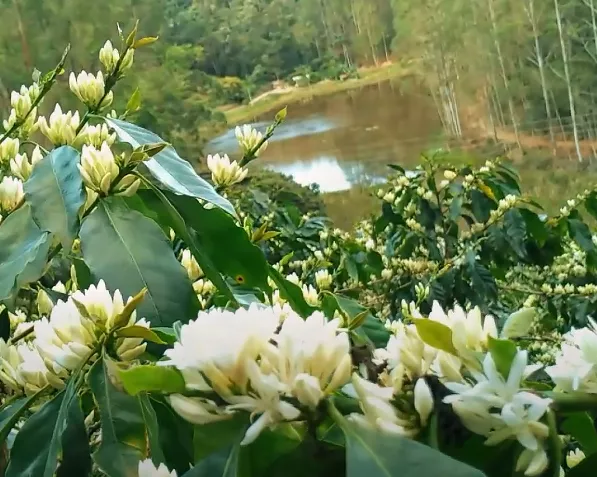 Coffee blossom coffee spread from Pará and arrived in Rio de Janeiro in 1770, but it was not until the early 19th century when demand increased in the United States and Europe The coffee was not made available for domestic consumption until the early 19th century, and created the first of two coffee booms. In 1820, coffee plantations in Rio de Janeiro, São Paulo and Minas Gerais rapidly expanded to account for 20% of world production. By 1830, coffee had become Brazil's largest export, accounting for 30% of world production. by 1840, both total exports and the share of world production reached 40%, making Brazil the largest coffee producer. The early coffee industry was dependent on slaves. 1.5 million slaves were imported to work in the plantations in the first half of the 19th century. in 1850, when the foreign slave trade was banned, plantation owners began to turn increasingly to European immigrants to meet the demand for labor. The slave trade lasted until 1888, when it was abolished in Brazil.
Coffee blossom coffee spread from Pará and arrived in Rio de Janeiro in 1770, but it was not until the early 19th century when demand increased in the United States and Europe The coffee was not made available for domestic consumption until the early 19th century, and created the first of two coffee booms. In 1820, coffee plantations in Rio de Janeiro, São Paulo and Minas Gerais rapidly expanded to account for 20% of world production. By 1830, coffee had become Brazil's largest export, accounting for 30% of world production. by 1840, both total exports and the share of world production reached 40%, making Brazil the largest coffee producer. The early coffee industry was dependent on slaves. 1.5 million slaves were imported to work in the plantations in the first half of the 19th century. in 1850, when the foreign slave trade was banned, plantation owners began to turn increasingly to European immigrants to meet the demand for labor. The slave trade lasted until 1888, when it was abolished in Brazil.
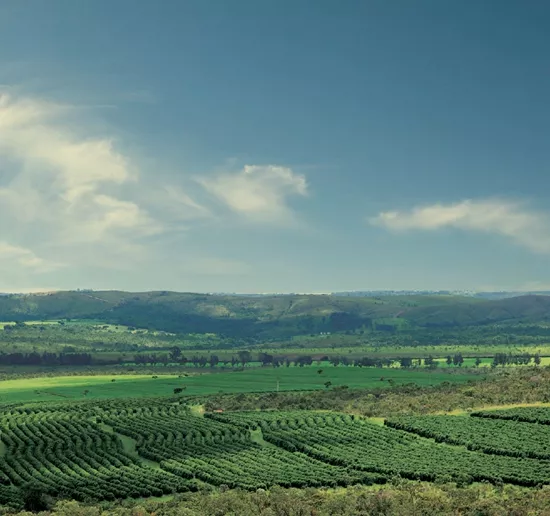 The second boom was from 1880 to 1930.
The second boom was from 1880 to 1930.
Coffee production in the Zona da Mata Mineira district increased by 90 per cent in 1880 and 70 per cent in 1920 in the state of Minas Gerais. Most workers were black, including slaves and freedmen. Increasing numbers of Italian, Spanish and Japanese immigrants provided an expanded labor force. The railroad system was established to bring coffee beans to market, but it also provided the necessary internal transportation for freight and passengers and developed a large skilled workforce. The growing coffee industry attracted millions of immigrants and took São Paulo from a small town to the largest industrial center in the developing world. by 1930, São Paulo's population exceeded one million, and Rio de Janeiro became the country's largest city and most important industrial center.
By the beginning of the 20th century, coffee accounted for 16 per cent of Brazil's gross national product and three quarters of its export earnings.
In 1920, Brazil had a virtual monopoly on the international coffee market, supplying 80 per cent of the world's coffee. Since the 1950s, the country's market share has steadily declined as global production has increased. Despite this decline in share and government attempts to reduce the export sector's dependence on a single crop, coffee still accounted for 60 per cent of Brazil's total exports by the end of 1960. By 1964, during the Cold War, there was a serious surplus of coffee production, and even with a series of policies to stimulate consumption, such as the "coffee break" introduced by the Pan American Institute, coffee consumption remained a drop in the bucket.
 Finally, under the pressure of the global coffee crisis, the International Coffee Organization (ICO) was born, an agreement signed by more than 60 coffee-producing and coffee-consuming countries around the world, which has finally led to the longest period of stability for dozens of coffee-producing countries, including Brazil, by limiting the amount of coffee imported and exported by producing and consuming countries through a quota system and stabilizing coffee prices.
Finally, under the pressure of the global coffee crisis, the International Coffee Organization (ICO) was born, an agreement signed by more than 60 coffee-producing and coffee-consuming countries around the world, which has finally led to the longest period of stability for dozens of coffee-producing countries, including Brazil, by limiting the amount of coffee imported and exported by producing and consuming countries through a quota system and stabilizing coffee prices.
But the good times did not last long, as the Brazilian states announced their withdrawal from the International Coffee Convention in 1989, at the end of the Cold War. The Brazilian Coffee Association controlled the price of coffee by regulating the amount of coffee grown and sold, repealing the provision limiting government intervention in favour of a free market.
Coffee growing
Brazilian coffee is generally grown on flatter terrain, and in order to adapt to local conditions, Brazilian estate owners have for decades developed improved Arabica coffee trees that do not require high ground and shade, and can be planted on plains or grasslands in direct sunlight, unlike the traditional shade cultivation method at higher altitudes.
Most of the Brazilian coffee plantations are only a few hundred meters above sea level, and even flat land is planted as usual. This exposure planting method makes the coffee fruit grow faster, the flavor is less fully developed, and the density of the beans is not as high as the high altitude beans, the fruit acidity is significantly lower, monotonous flavor.
Coffee cherries are collected by hand in most areas so that only the full red fruit can be collected, but in Brazil, the large plain plantings, ideal for mechanized harvesting, mean that a large number of immature coffee cherries are also harvested, resulting in a harvest that is not as high quality as that collected by hand.
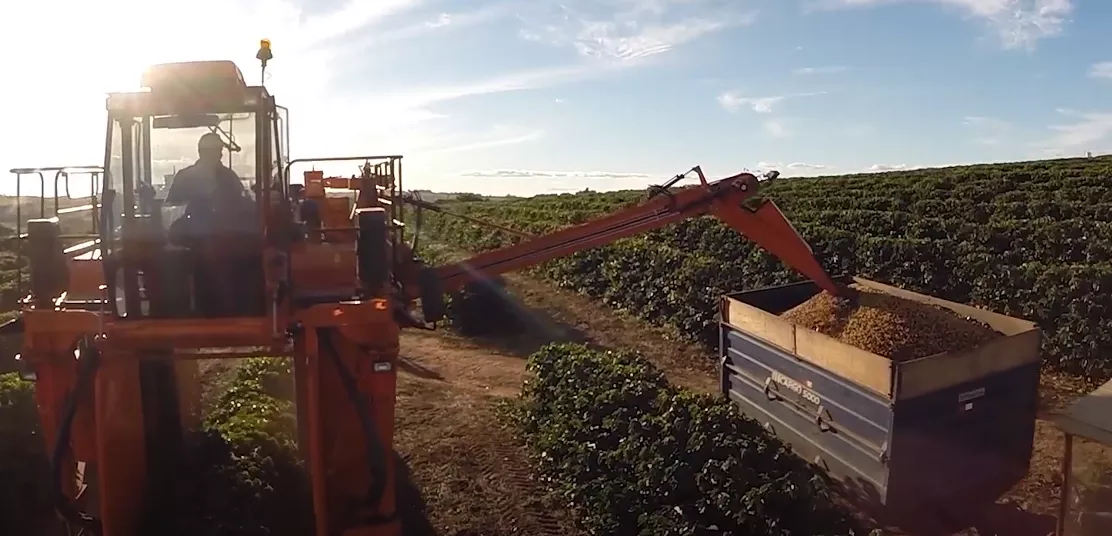 Brazilian Mechanical Harvesting To improve on this, some farms have built custom harvesters that pick only ripe coffee cherries. Leaving the unripe berries to ripen further.
Brazilian Mechanical Harvesting To improve on this, some farms have built custom harvesters that pick only ripe coffee cherries. Leaving the unripe berries to ripen further.
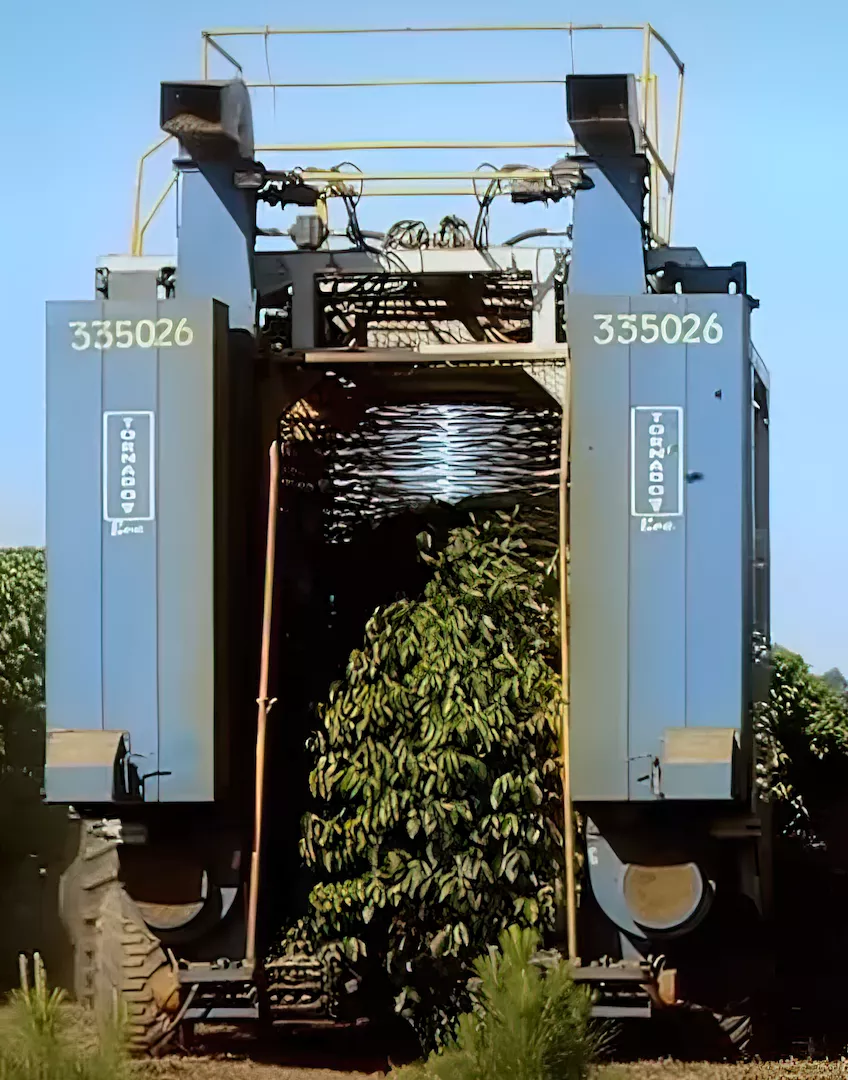 Daterra Coffee Farm Specialty Harvester that screens out unripe fruit from being collected (somewhat similar to a color sorter) .
Daterra Coffee Farm Specialty Harvester that screens out unripe fruit from being collected (somewhat similar to a color sorter) .
Coffee-producing regions
Places with very interesting coffee origins have a coffee association of their own. Brazil is no exception.
The Brazilian Boutique Coffee Association (BSCA), located in Varginha, Minas Sur, is a non-profit coffee organization founded in 1991 by 12 Brazilian coffee producers who came together.
 The BSCA aims to improve the quality of indigenous coffee production in Brazil, as well as to promote the commercialization and industrialization of Brazilian coffee, while contributing to the development of ecological agriculture through cooperation between national and international organizations. The BSCA aims to improve the quality of indigenous coffee production in Brazil, as well as to promote the commercialization and industrialization of Brazilian coffee, and to contribute to the sustainable development of coffee-growing regions through cooperation between national and international organizations involved in the development of ecological agriculture.
The BSCA aims to improve the quality of indigenous coffee production in Brazil, as well as to promote the commercialization and industrialization of Brazilian coffee, while contributing to the development of ecological agriculture through cooperation between national and international organizations. The BSCA aims to improve the quality of indigenous coffee production in Brazil, as well as to promote the commercialization and industrialization of Brazilian coffee, and to contribute to the sustainable development of coffee-growing regions through cooperation between national and international organizations involved in the development of ecological agriculture.
According to data identified by the Brazilian Coffee Association, there are 32 regions and more than 14 states that produce coffee.
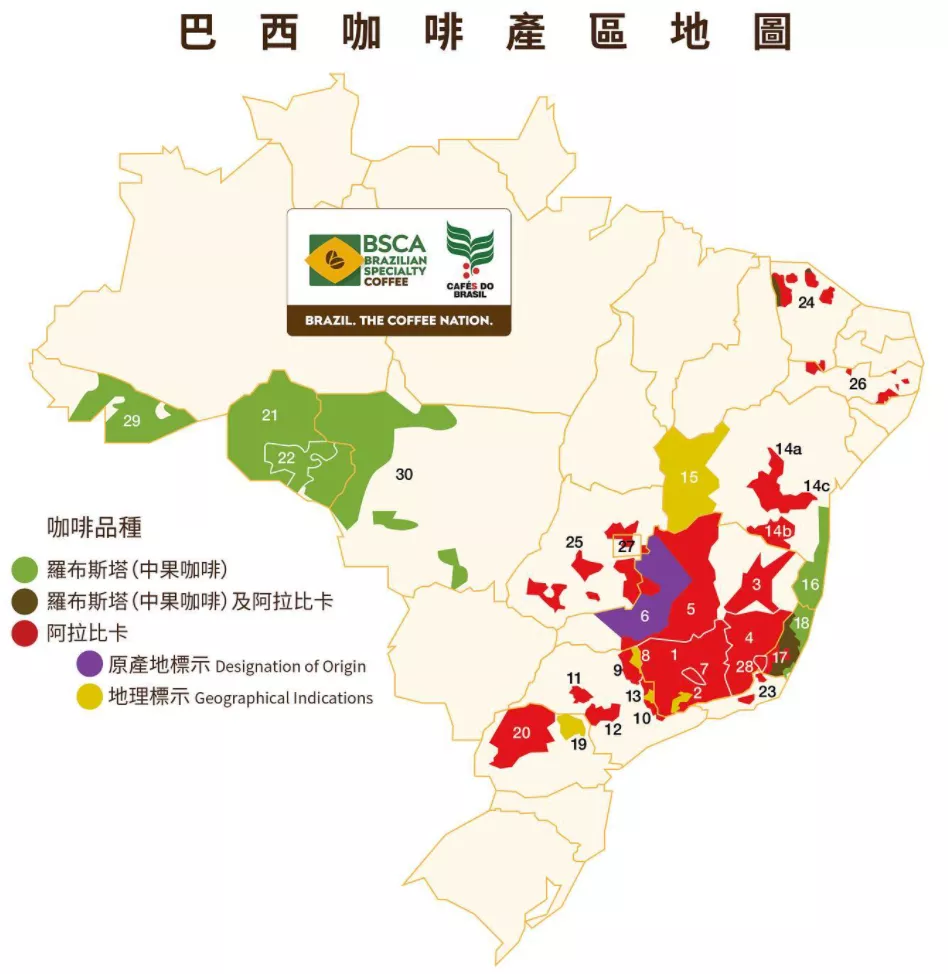 Of these 27 states and the Federal District, seven have the largest coffee production.
Of these 27 states and the Federal District, seven have the largest coffee production.
- São Paulo State (Mogiana, Centro-Oeste)
- State of Paraná (Norte Pionerio do Paraná)
- Bahia (Planaltoda Bahia, Cerrado da Bahia, Atlántico Baiano)
- Espírito Santo (Montanhas do Espírito Santo, Conilon Capixaba)
- State of Minas Gerais (Sul de Minas, Cerrado Mineiro, Chapada de Minas, Matas de Minas)
- Rondônia
- Rio de Janeiro State (Rio de Janeiro)
The total production of these 7 states is close to more than 90% of Brazil's national production. Let's focus on the four largest Brazilian states.
Minas Gerais (MINAS GERAIS)
Minas Gerais is the largest coffee producer in Brazil, accounting for nearly 50% of the country's total production. It is also the main producer of Brazilian specialty coffees. It has a total of four large production areas.
Sul de Minas
South of Minas is at a high altitude, averaging 950 metres above sea level, with an annual temperature of around 22 degrees Celsius. It also produces 30 per cent of the country's coffee, mainly on small farms of 10 to 100 hectares, although the size can vary considerably.
Cerrado de Minas
Hirado was the first coffee producing region in Brazil to be granted the status of "Origin" (Cerrado Mineiro). It is a large region, consisting of 55 municipalities, located between Alto Paranéba, Delta Mineiro and north-western Minas Gerais. Its farms range from medium-sized (2-300 hectares) to large estates.
 The area is 800-1300 meters above sea level and has four distinct seasons (humid summers and mild to dry winters), making it ideal for producing specialty coffees. You can find Mundo Novo and Catuaí here, Cerrado de Minas coffees usually have a high acidity, medium taste and sweetness.
The area is 800-1300 meters above sea level and has four distinct seasons (humid summers and mild to dry winters), making it ideal for producing specialty coffees. You can find Mundo Novo and Catuaí here, Cerrado de Minas coffees usually have a high acidity, medium taste and sweetness.
Chapada de Minas
The highlands of the Chapada de Minas are scattered with valleys suitable for mechanized production. catuaí and Mundo Novo are both grown here.
Matas de Minas
Matas de Minas is located in the Atlantic Forest, with undulating terrain and a warm and humid climate. Eighty per cent of its production farms are less than 20 hectares in size.
São Paulo (SÃO PAULO)
São Paulo was one of the first states in Brazil to grow coffee historically. It is also home to the port of Santos, Brazil's main port for coffee exports. Its main sources of production are.
Mogiana
With an altitude of 900-1100 meters, an average temperature of 20°C throughout the year, and a hilly terrain, Mojuana has a nice sweetness and balance to the coffee.
Centro-Oeste de São Paulo
This region is made up of the municipalities of Marilia, Garça, Ourinhos and Avaré. Like Mojuana, it is a hilly terrain. Most of the farms are small to medium sized.
![] (https://img.16k.club/techlife/2022-05-01/517a3d617379850030c92e62eab1c58f.webp) Coffee farms in Mojuana #### Espírito Santo (ESPÍRITO SANTO)
Espírito Santo is the second largest coffee producer in Brazil, but also the largest producer of Robusta coffee. The coffee here is grown on small family farms, and even though yields are low, these farms still insist on producing high quality coffee. The larger production areas of Espírito Santo are.
Montanhas do Espírito Santo
Montanhas is a highland region with moderate temperatures and altitudes between 700 and 1,000 meters above sea level, producing a satisfying boutique coffee. The region is known for its high acidity and fruitiness.
Conilon Capixaba
Conilon is a Brazilian Robusta coffee that is usually grown on small plots of land at low altitudes.
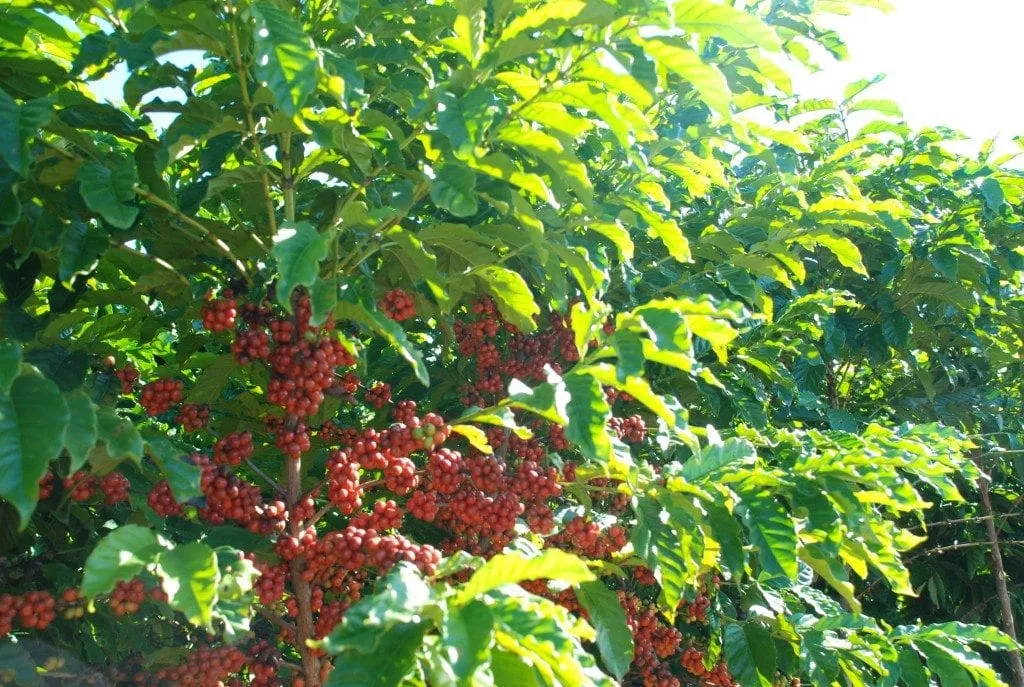 Conilon's Robusta Coffee #### Bahia (BAHIA)
Conilon's Robusta Coffee #### Bahia (BAHIA)
Bahia is located in northeastern Brazil, where coffee farming began in the 1970s. But it is already known for its quality coffee beans and technology. About 75% of the crop is Arabica.
In Bahia, there are 2 better-known appellations.
Cerrado and Planalto da Bahia
This appellation, with its high altitude and warm climate, has dry summers and rainy winters. And it is the most technologically advanced coffee producing region in Brazil. From planting to harvesting, everything is mechanized.
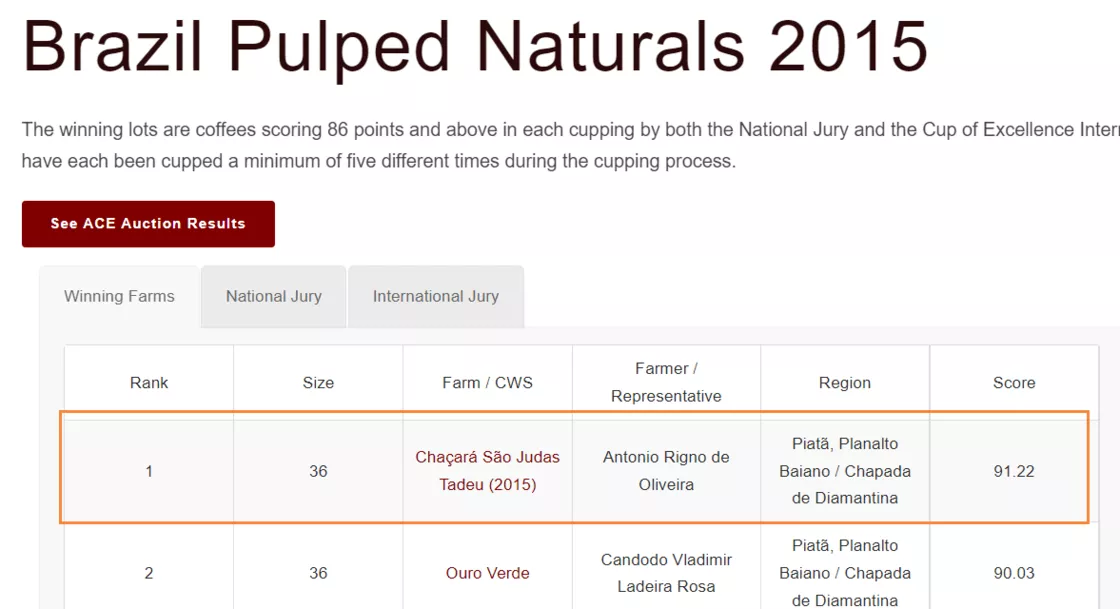 And the best thing about this appellation is not that, but that Antônio Rigo de Oliveira from the Chaçará São Judas Tadeu farm in Piatã municipality Antônio Rigo de Oliveira from Chaçará São Judas Tadeu Farm in Piatã won the 2015 Brazilian Cup of Excellence (COE) in the semi-sun category (with a score of 91.22 points).
And the best thing about this appellation is not that, but that Antônio Rigo de Oliveira from the Chaçará São Judas Tadeu farm in Piatã municipality Antônio Rigo de Oliveira from Chaçará São Judas Tadeu Farm in Piatã won the 2015 Brazilian Cup of Excellence (COE) in the semi-sun category (with a score of 91.22 points).
Atlantico Baiano
This region, like Conilon, grows mainly Robusta.
Famous estates
There are conservatively estimated to be about 220,000 coffee plantations in Brazil; covering an area of about 27,000 square kilometres, and over the 150 years of coffee farming have also given rise to some great coffee estates, such as.
Estate Name State/Region Hope Estate South Minas Ipanema Estate South Minas Santa Yn Estate South Minas Queen Estate Mojuana Santeo/Shinoki Estate South Minas Datura Estate Hirado Green and Gold Estate Bahia State Bahia Estate Hirado St. Jude Estate Bahia State Santa Isabel Estate South Minas Ilarima Estate Mojuana Coffee Tree Seeds
The main varieties grown in Brazil are Catuaí, Mundo Novo, Icatu and Bourbon, the more common being Carduai, Bourbon and Icatu. Among them, Catuaí and Bourbon have been systematically introduced before. This time we will focus on Mundo Novo and Icatu.
New World (Mundo Novo)
Mundo Novo New World, is a natural cross between Bourbon and Tippecka species. The plants are stronger, more productive and more resistant to pests and diseases, although they take longer to mature. The beans are rounded and have a large grain size, averaging up to 17 mesh. It grows well at altitudes above 800m and in areas with 1200-1800ml of rainfall, which is a good match for the Brazilian soil. First discovered in the São Paulo region of Brazil in 1943, the New World was first grown in the city of Novo Mundo, now known as Urupês.
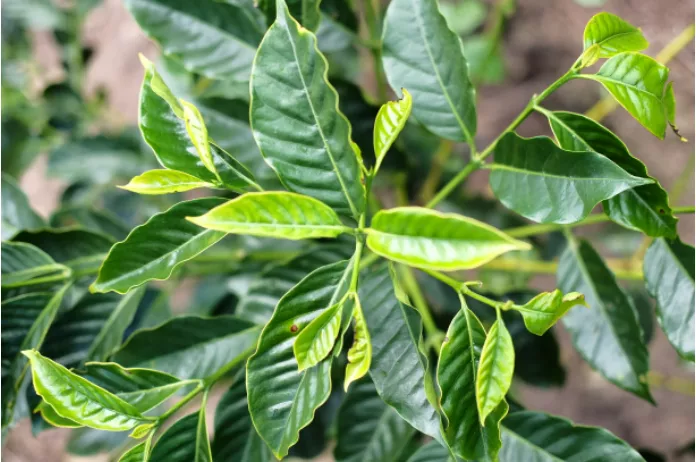 The first selections of Mundo Novo were made between 1943 and 1952. Since 1952, the variety has been distributed to farmers in Brazil. Starting in 1977, the IAC (Instituto Agronómico de Campinas), an agronomic institute in Brazil, released a new variety. The variety is relatively common in Brazil and other South American countries, but is hardly grown in Central America.
The first selections of Mundo Novo were made between 1943 and 1952. Since 1952, the variety has been distributed to farmers in Brazil. Starting in 1977, the IAC (Instituto Agronómico de Campinas), an agronomic institute in Brazil, released a new variety. The variety is relatively common in Brazil and other South American countries, but is hardly grown in Central America.
Icatu (ICATU)
ICATU is a relatively new variety, only officially released in 1993 by the Agronômico de Campinas Institute (IAC) in Campinas, Brazil. It is a super complex cross. First it is Arabusta, a cross between Arabica and Robusta, and then it is a multi-generational cross between Arabusta and Arabica varieties such as Cardura, New World and Bourbon. Year by year, the crude flavors of Robusta were reduced and the strengths of Arabica were increased, resulting in Icatu, which has more Arabica blood than Robusta.
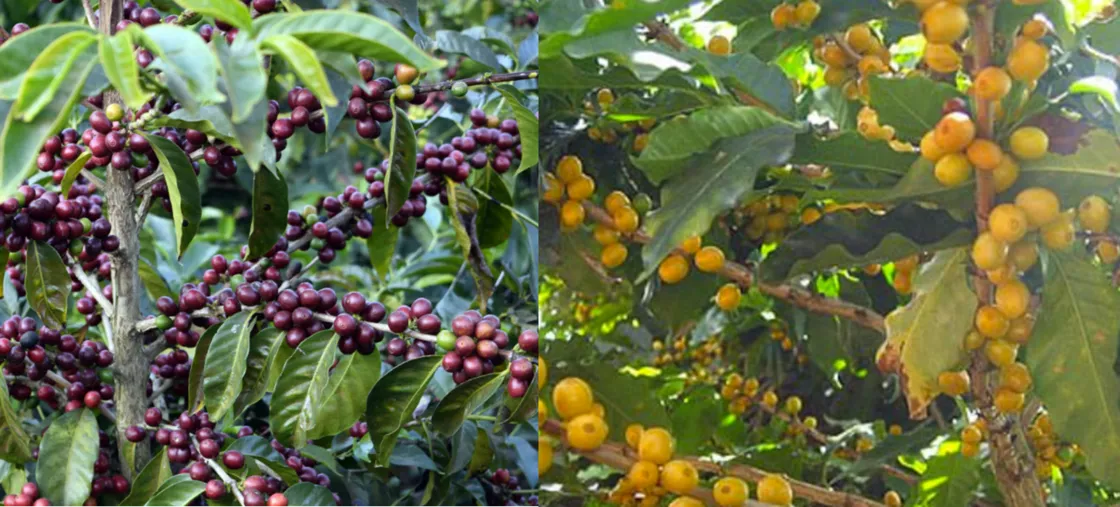 Left- Red Icatu / Right- Yellow Icatu crossed ICATU with strong resistance to leaf rust and root knot nematode ability. It is divided into Red Icatu and Yellow Icatu. the best result known for Icatu is the 26th place in the COE tanning group in Brazil in 2020.
Left- Red Icatu / Right- Yellow Icatu crossed ICATU with strong resistance to leaf rust and root knot nematode ability. It is divided into Red Icatu and Yellow Icatu. the best result known for Icatu is the 26th place in the COE tanning group in Brazil in 2020.
Proof that this breed has the ability to continue to improve.
Its flavor profile is low acidity, medium body, sweet dark chocolate, with a hint of lemon.
treatment method
Prior to 1990, treatment in Brazil was essentially exclusively by solarization, and after 1990, the semi-sun or semi-wash method was invented. Both are correct, as the entire process is based on the traditional sun and wash process. But the correct name for it would be: Pulped Natural (pulp sunning).
Processing:
Sorting: The coffee fruit is first filtered through a sifter to remove twigs, leaves, stones, etc. and the fruit is washed with water to remove dust.
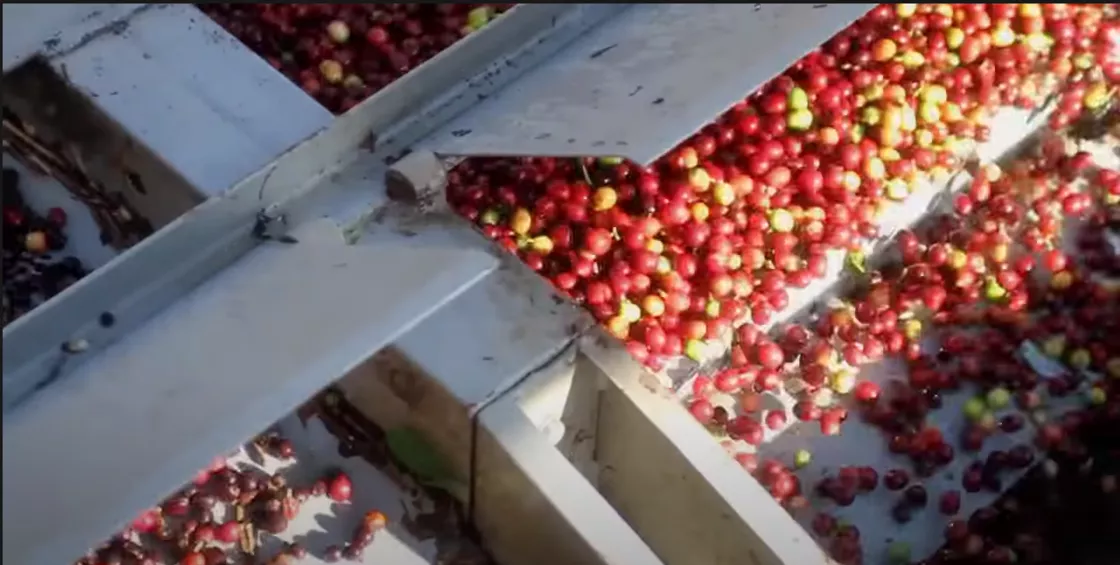 Peel and pulp removal: coffee fruit first through the water tank to remove defects floating fruit, followed by shaving the peel, pulp and part of the gum layer, and then water washing for an hour, due to The water immersion fermentation time is very short, and the pectin is not easily washed off in its entirety.
Peel and pulp removal: coffee fruit first through the water tank to remove defects floating fruit, followed by shaving the peel, pulp and part of the gum layer, and then water washing for an hour, due to The water immersion fermentation time is very short, and the pectin is not easily washed off in its entirety.
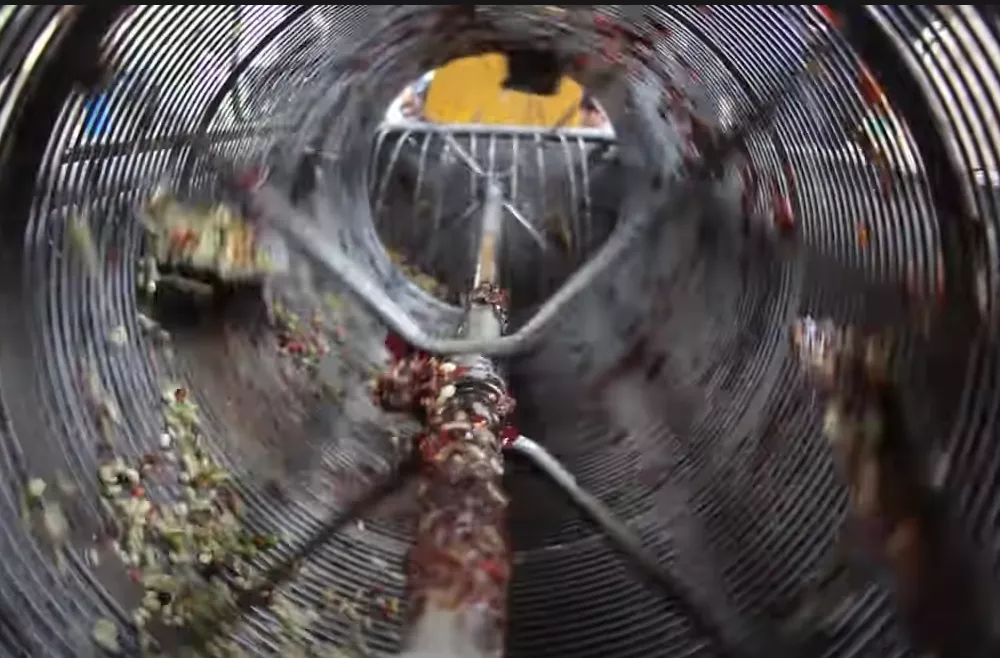 Drying: the pectin still remains on the shells, at which point the sticky shelled beans are then laid out to dry in the aeration field.
Drying: the pectin still remains on the shells, at which point the sticky shelled beans are then laid out to dry in the aeration field.
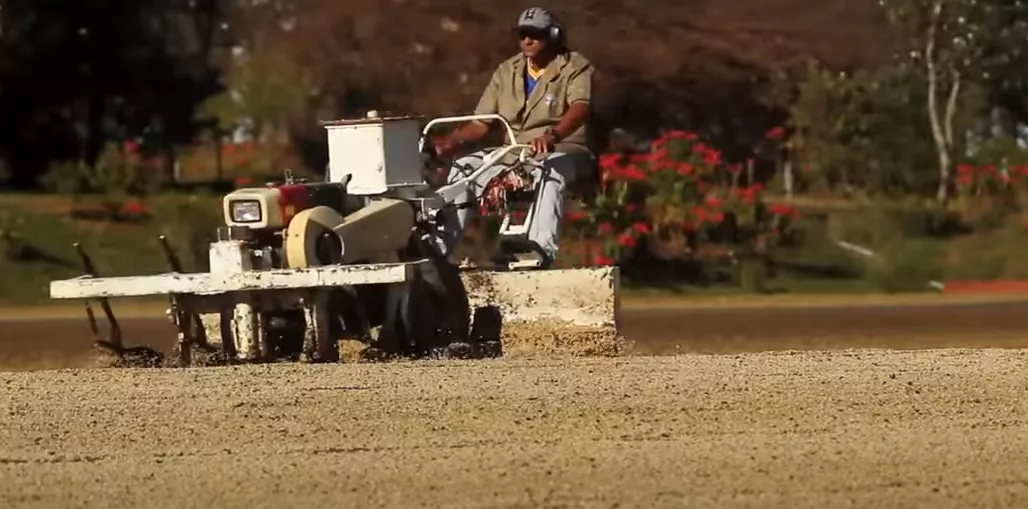 Such semi-sun-drying treatment saves a lot of water compared to washing treatment, reduces costs, and the number of days of sun-drying compared to traditional sun-drying is also substantially It also avoids bad odors from excessive fermentation and dusty pest infections on the ground.
Such semi-sun-drying treatment saves a lot of water compared to washing treatment, reduces costs, and the number of days of sun-drying compared to traditional sun-drying is also substantially It also avoids bad odors from excessive fermentation and dusty pest infections on the ground.
 Raw bean grading
Raw bean grading
The Brazilian grading system for coffee beans is based on defects, size and cupping, and is unique to Brazil and therefore more complex than other countries. The reason Brazil is divided into three stages is due to the large origin and production of Brazil, which tends to make the quality of the beans inconsistent and therefore requires cupping to confirm the integrity.
Let's start with an example of Brazilian product naming: Brasil Santos NY.2 SS FC
- Brasil: for country, Brazil
- Santos: indicates production area/port area, from Puerto Santo Domingo
- SS FC: refers to the grading of taste by cup test.
- Strictly Soft Fine Cup (extremely smooth good coffee)
Let's start by understanding the defective grading method, which is called the New York Method (NY) meaning that the number of defective beans per 300g is graded as follows.
Grading number of defects (per 300 grams)NY.26NY.2/39NY.313NY.3/421NY.430NY.4/545NY.560NY.5/6 > 60 Looking again at grading based on cup test taste results.
Grades Cup Test Taste Description Grade I Strictly Soft Extremely Smooth Grade II Soft Smooth Grade III Softish Slightly Smooth Grade IV Hard Slightly Astringent Grade V Hardish Hardly Astringent Grade VI Rio/Rioy Iodine with a pesticide soil odor on the nose Grade VII Rio Zona Strong Iodine, more intense than Iodine The last one. That's the six-level cup test grading system
Grades Cup Test Taste Grade I Fine Cup (FC) Grade II Fine Grade III Good Cup (GC) Grade IV Fair Cup Grade V Poor Cup (PC) Grade VI Bad Cup (BC) Fine Cup and Good Cup are the 2 most common grades. The others are hard to find in the general consumer market.
lastly
Brazil is a country with a long history of coffee cultivation, which, due to its special geographical advantage of plains, can be grown on a large scale, saving labor costs and increasing efficiency through purely mechanized harvesting. However, it also affects the degree of fine quality to a certain extent. So at present, Brazil is still the main bean of commercial blending coffee.
Most of the Brazilian base bean flavors are concentrated in the categories of nuts, cocoa, chocolate, and toast. The mouthfeel is smooth, with medium body and low acidity.
And the few Brazilian boutique coffee beans that are currently available have a great change in flavor, with acidity and sweetness like lemon, plum, and sugar cane. A huge improvement, so to speak.
Reference.
- Map of Brazil's production areas: BSCA Brazil Fine Coffee Association
- Brazil production: Brazil's Ministry of Agriculture expects 55.74 million bags of coffee this year, planted area largely unchanged - coffeefinance.com
- International Coffee Convention: https://www.ico.org/
- 巴西咖啡产区:https://perfectdailygrind.com/2016/04/a-concise-guide-to-brazils-major-coffee-producing-regions/